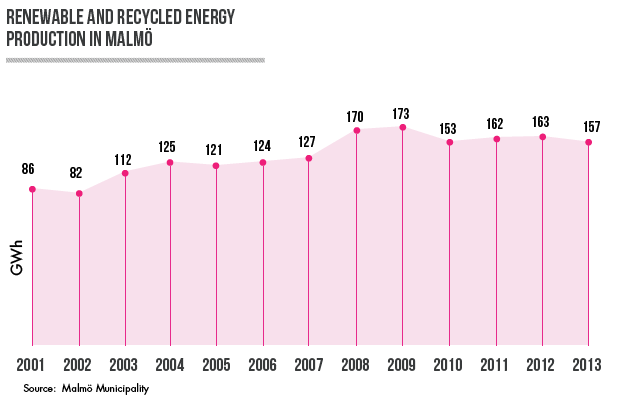![]() 5 minute read
5 minute read
How to transform industrial centres into environmentally-friendly and low-carbon areas? Ask Sweden! Industrial centers in the past are now the benchmarks and case studies of efficient ecological design.
Insight box
Swedish experience proves that new green urban areas do not have to be build on the new territories. EcoCity is a complicated organism, which combines ecological reusable building materials, waste recycling and water purifying systems, economical water usage, renewable energy production and excellent public transport connections.
Transforming failure into the biggest success: Hammarby Sjöstad
Located couple kilometres away from Stockholm Centre, Hammarby Sjöstad used to be mainly industrial zone. Initially, city’s eco-transformation was designed in order to be the most environmentally sustainable host-city ever for the 2004 Summer Olympic Games. The bid was lost to London, but it did not stop on-going transformation. Eventually, it became an example of Eco-City and helped Stockholm to win the European Green Capital 2010 award.
How to transform old industrial
district into prosperous green
Having a plan to lower area’s total environmental impact by half, the City of Stockholm bought the site from private owners, cleaned and re-built with ecologically clean materials. In order to deliver the master plan, the project was designed and developed by a number of architecture firms and 40 building contractors. Built from the ground up, with new public transport routes, district heating and cooling and an underground waste collection system, area is to contain around 1 000 apartments for more than 26 000 inhabitants. Moreover, the Green transport, as one of the main features of Eco[nbsp]City, is provided in the area with public transport and car sharing scheme, both fuelled by bio-gas. Free ferry service and tramline take citizens to Stockholm Centre. Initially, the ambitious environmental target included average car ownership of only 0.5 cars per unit, so that residents commute to work using public transport, bicycles and carpools rather than by individual vehicles. Nevertheless, on practice this target is 80% completed. Moreover, with the purpose of noise pollution reducing, the road alongside the development has been lowered by two meters. An outstanding stationary vacuum waste system delivers solid waste via underground pipes to central points for collection, where is converted into heat energy and bio-gas for use in district heating plants and public transport vehicles.
Developing common
responsibility
Apartment blocks are equipped with solar panels or solar cells incorporated into their fabric. Furthermore, due to economical water system in the buildings, average water use is around 150 litres, compared to a city average of 200 litres. The Social behaviour has changed and developed the common responsibility. Households in Hammarby Sjöstad are not billed individually for their water consumption, but by districts. Consequently, without their incentive to reduce bills, further water use reductions are unlikely in the short-term.
Västra Hamnen, Malmö, where high demands on aesthetics, ecology and high technology are combined
In 2001, the Project Bo01 launched the transformation of the defunct shipyard into a green and sustainable district. To meet eco- and sustainable standards, the ground was cleaned before construction and prepared for ecological buildings (all materials are reusable when buildings are demolished).

Since the beginning of the project Malmö has achieved excellence[nbsp]in water and power provision. As for energy production, area is provided by 100% renewable energy by solar panels on the building roofs, solar and wind power plants. In addition, biogas is produced from solid waste to heat homes and power vehicles. Water provision happens by rainwater-harvesting and grey-water treatment in the city’s purification post. An important part of the concept is low energy use in the buildings with low allowance of 105 kwh/m²/year per. However, not all given targets have been achieved yet, but Western Harbour has already become a place of pilgrimage for policy makers, city planners, architects and others to experience one of the most advanced examples of sustainable urban development to date.
Gaining public
transport popularity
The eco-transportation system is planned to illuminate the traffic and private-transport usage, therefore, efficient and fast buses along with[nbsp]car pool are available for residents. The secret of public transport[nbsp]popularity is its short-intervals runs and close-to-home bus stops.
Start from pieces to improve the whole image
Sweden is famous for its Green Building development around the country. Numbers of office buildings are refurbished in order to cut energy consumption. Particularly, due to climate features, office buildings are implemented with geothermal heat pumps, collecting heat from the ground during heating season and recapturing heat into the ground during cooling, in other cases buildings are supplied by district heating and cooling. In addition, installed control systems for controlling and monitoring the buildings heating- and cooling systems aiding to reduce energy consumption. Consequently, energy savings constituted significant percentages even up to 80%.
To sum up, Sweden is one of the countries to meet the demand of new living areas due to population growth and to design Eco-Cities setting new standards for world sustainable living.
Sources
Hammarby Sjöstadt Case Study, Nicole Foletta, ITDP Europe, 2011
Hammarby Sjöstad, Stockholm, Sweden 1995-2015
Malmö Municipality, “Sustainable Urban Planning in Malmö”
Bo01 City of tomorrow, (Malmö –SE), 2014
Miljöredovisning 2014, Malmö Stads redovisningar, 2014




